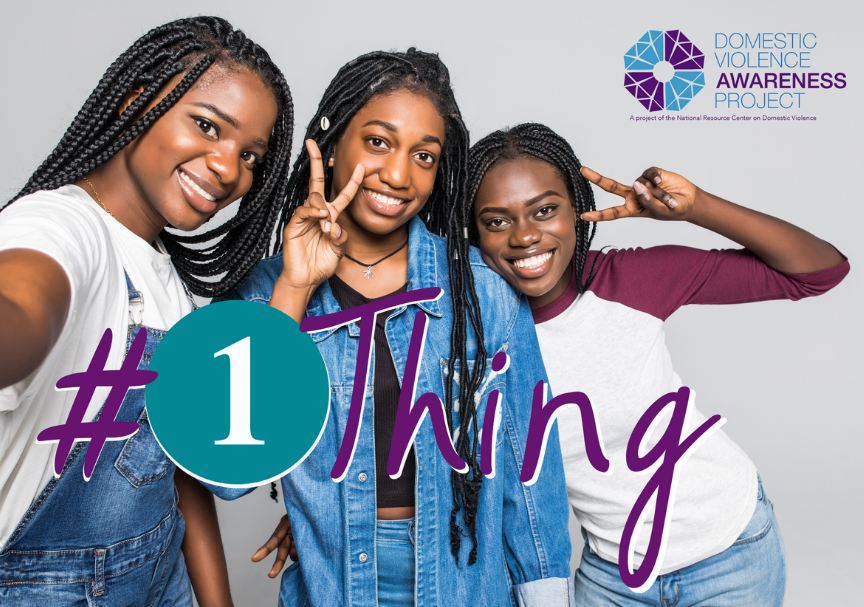By Breckan Winters, Program Specialist at NRCDV
Youth engagement is a key strategy for preventing gender-based violence. Young people have always been on the front lines of our social justice movements, pushing us to be bolder and more innovative. We need young people to move this work forward. True intergenerational partnership that values what each person brings to the table is a beautiful thing.
It is particularly important to include young people’s voices when planning any youth-serving programs. As the saying coined by disability rights activists goes, “nothing about us without us.” Any attempts to work with or on behalf of young people (or any other marginalized group) that do not center their voices and experiences will fall flat. Or worse – they will replicate the anti-Blackness, ageism, and other forms of oppression that advocates and activists seek to dismantle. Developing a youth advisory board (YAB) can be a great way to ensure that Black youths’ voices guide your work in a meaningful way. This TA Question of the Month offers some key considerations for forming and sustaining a youth advisory board for your domestic violence organization.
"We are not their mothers or teachers or coaches. We are working in partnership with youth to support their organizing.” – Casey Keene, How can my organization incorporate an intergenerational activism model?
Forming Your YAB
Before getting started, remember that the most critical piece of this work is to partner with young people each step of the way. As Girls for Gender Equity states, “young folks are experts who will organize and lead an intergenerational movement for gender equity rooted in Black feminism.” Youth should be involved in all aspects, including planning, development, and program implementation. Does your organization have existing relationships with young people, or with youth-serving programs? If so, nurture those relationships! Follow the lead of Black youth leaders in every step of this process.
The webinar Creating and Developing a Youth Advisory Council by the National Youth Leadership Council (NYLC) offers four key steps for creating a YAB: 1) identify desired results, 2) determine acceptable evidence, 3) engage in student activities, and 4) self-assessment.
- Identify desired results. What do you want the youth advisory board to accomplish and/or learn? Remember, youth should be empowered to work on projects that feel meaningful to them. Perhaps your board will be interested in a dating violence prevention campaign on social media. Maybe they will want to focus on ending the school to prison pipeline for Black girls. Keep an open mind and follow their lead!
- Determine acceptable evidence. How will you know that the YAB is accomplishing its goals? Will it work to complete a specific project? Will youth complete exit surveys at the end of their time on the board to assess whether they viewed their work as worthwhile? Consider what will make sense for your circumstances.
- Engage in student activities. This is the time to do the work that your YAB set out to accomplish. For best outcomes, NYLC encourages organizations to follow the eight service-learning standards for quality practice: meaningful service, link to curriculum (if working within an education setting), reflection, diversity, youth voice, partnerships, progress monitoring, and duration and intensity.
- Self-assessment. What worked well during this process? What didn’t? Be sure to note lessons learned and to look for ways to deepen your support of youth leaders.
Remember that there is no one size fits all approach! Find what works best for the young people in your community. For sample forms, agendas, materials and lessons learned based on experience working with youth, see the Indiana Coalition Against Domestic Violence’s Youth Council Toolkit. To see an example of a Black youth-led YAB in action, check out JAIA’s YOUth leadership council!
Considerations for Sustaining the Work of the YAB
Center those most marginalized. It bears repeating: any project that doesn’t center those most impacted will fall flat, or worse, cause harm. Commit to dismantling anti-Blackness by following the leadership of Black youth. “Black power and innovation are strong enough to create new and liberating systems.”
Step back and let youth lead. In PreventConnect’s Letting Youth Lead: Directions in Prevention podcast, youth activist Kaile Fernandes emphasizes the importance of “facilitating conversation, rather than controlling the conversation.” Control is a tool of white supremacy. The importance of letting youth guide this process cannot be overstated.
 Build authentic relationships with your YAB members. At NRCDV, our Director of Racial Equity & Social Change Jacqueline Miller often reminds us to be relational as opposed to transactional in our relationships. Building a world centered in racial and gender equity requires us to be relational. Take time to invest in deep, two-way relationships with young people. Do not focus solely on what your organization can “get” out of the youth advisory board (or worse, get caught in the mindset that partnering with young people is a favor to them because it gives them “experience”).
Build authentic relationships with your YAB members. At NRCDV, our Director of Racial Equity & Social Change Jacqueline Miller often reminds us to be relational as opposed to transactional in our relationships. Building a world centered in racial and gender equity requires us to be relational. Take time to invest in deep, two-way relationships with young people. Do not focus solely on what your organization can “get” out of the youth advisory board (or worse, get caught in the mindset that partnering with young people is a favor to them because it gives them “experience”).
Engage in self-reflection in order to be a good adult ally. Adults doing this work must challenge any internalized ageism that comes up. And be sure to tend to your own healing, too. As Annika Leonard writes, “we must reconnect to our truth to create the intergenerational space needed to end violence. The process of remembering what we have endured as children, young adults and in adulthood will assist us in creating this space, but only when we bring our whole selves to the work in an authentic way.”
Invest in YAB members’ well-being. This is challenging, personal work. Build opportunities for healing and self-care into your time with youth. Invest in their wellness in tangible ways too – compensate them! This shows your youth advisory board members that you value their time, knowledge, lived experiences, and ideas.
Learn more:
Organizations
- JAIA is a personal development and leadership program that partners and co-creates with youth in order to promote mindful, healthy and safe communities through transformative personal and leadership development.
- Girls for Gender Equity works intergenerationally, through a Black feminist lens, to achieve gender and racial justice by centering the leadership of Black girls and gender-expansive young people of color to reshape culture and policy through advocacy, youth-led programming, and shifting dominant narratives.
Resources
- TAQ: How can we harness the power of our own trauma histories to build truly intersectional and intergenerational approaches to this work? by Annika Leonard
- Engaging Youth in IPV Prevention: Lessons Learned from DELTA FOCUS by NRCDV
- Creating and Developing a Youth Advisory Council by National Youth Leadership Council
- Youth Advisory Councils: Eight Steps To Consider Before You Engage by YouthPower Learning
- Creating and Sustaining a Thriving Youth Advisory Council by Adolescent Health Initiative
- Sustainability Strategies for Youth Advisory Boards: A Symposium on Youth Engagement by Center for Court Innovation
- Creating Youth Advisory Councils: Lessons Learn by Youth and Adults by Kaiser Permanente
- Nurturing black youth activism by The Chicago Reporter
- Youth Activist Toolkit by Advocates for Youth
- Podcast: Hope, Prevention and the Power of Young People by PreventConnect
- Web Conference: Moving Power: Authentically Engaging Youth in the Community to Prevent Sexual and Intimate Partner Violence by PreventConnect














